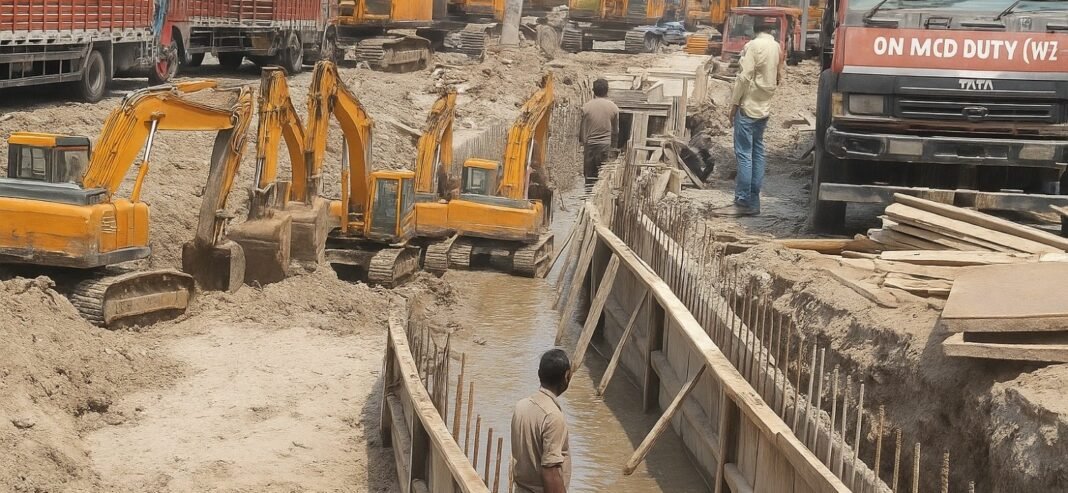New Delhi – The overhaul of what is widely regarded as the national capital’s most deteriorated stretch—National Highway-10 or Rohtak Road—is progressing slowly, with full completion expected by April 2026. Public Works Department (PWD) officials have stated that the ₹167 crore project to revamp the drainage system is just 31% finished since its commencement in January 2025.
The multi-phase project aims to end long-standing issues such as potholes, stagnant water even during dry days, and recurring vehicle breakdowns. Despite current setbacks, officials assure that key upgrades will be in place before the monsoon season next year, promising a smoother ride for daily commuters.
Drainage Overhaul in Three Phases
A senior PWD official confirmed that the entire drainage revamp is being implemented in three phases, with each addressing crucial stretches of the 13.23-kilometre corridor between Peeragarhi Chowk and Tikri Border. The major focus is on laying 9 km of stormwater drains along both sides of the highway. The sections under development connect the Kirari Suleman drain near Nangloi railway station to the Hirankudna drain via metro pillars 428 to 626, and then from pillar 753 to 626 toward Tikri Border.
“These new drains will significantly boost the area’s drainage capacity. With increased width and depth tailored to the growing population, waterlogging and road damage should become issues of the past,” the official explained. The current drainage system, unable to handle the influx from unplanned residential growth, has been a primary cause of flooding and road deterioration in areas like Nangloi, Mundka, Ghevra, and Tikri.
Ongoing Problems Despite Progress
Despite assurances of progress, commuters remain deeply frustrated with the current state of the road. “Large craters near Mundka metro station make the road nearly impassable,” said Vishal Lochab, a Tikri resident and daily commuter. “It’s dangerous and exhausting. If an accident happens, who will be held accountable?”
Another commuter, Rajendra Dabas, echoed similar concerns: “Potholes are everywhere—from Peeragarhi to Tikri. Beyond traffic jams, the dust and bad air are affecting our health. People are now avoiding the road and preferring the metro. The authorities need to act faster.”
PWD officials admitted that while temporary pothole repairs have been initiated, these will not last without a permanent drainage solution. “The heavy vehicular load will keep damaging the road unless we resolve the underlying water accumulation problem,” an official noted.
Parallel Road Repair Underway
Alongside the drainage work, the PWD is also repairing and strengthening a 4.5-km stretch of the road between Nangloi Metro Station and Tikri Border. This part of the project, budgeted at ₹3.3 crore, is running parallel to the drainage installation to minimize overall delays.
Coordination with NHAI for Long-Term Management
In a strategic move earlier this year, the Delhi government announced plans to transfer responsibility for the Delhi-Rohtak Road from Peeragarhi Chowk to Tikri Border to the National Highways Authority of India (NHAI). This transfer, finalized in June, is part of a broader plan to upgrade key corridors such as Ashram to Badarpur, MG Road, and Rohtak Road into expressways with modern infrastructure.
Chief Minister Rekha Gupta emphasized that the consolidation of road and drainage development under a single agency—NHAI—will streamline operations. “Earlier, multiple agencies led to uncoordinated drainage systems and delays. Now, with NHAI handling everything with PWD’s support, we expect long-term solutions and better accountability,” she said during a press briefing in June.
Looking Ahead
PWD maintains that while the entire project will conclude by April 2026, most critical work—especially related to drainage and pothole repairs—will be done well before the next monsoon season. The completed system is expected to benefit not only thousands of commuters on the Delhi-Haryana route but also residents in adjacent colonies who have long dealt with poor infrastructure.
Until then, commuters must navigate daily challenges on this battered yet vital stretch—hoping the promised transformation finally materializes








